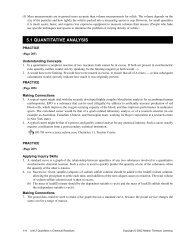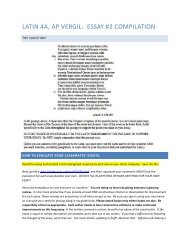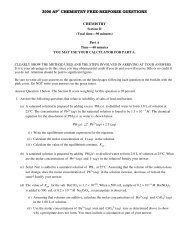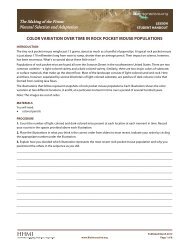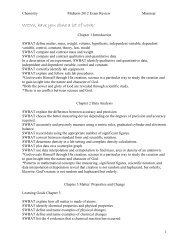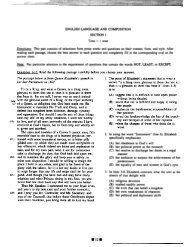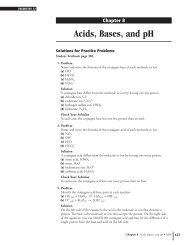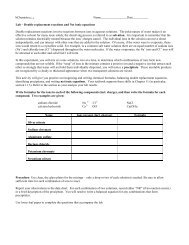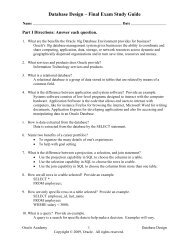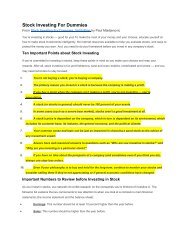VSEPR Powerpoint - Quia
VSEPR Powerpoint - Quia
VSEPR Powerpoint - Quia
Create successful ePaper yourself
Turn your PDF publications into a flip-book with our unique Google optimized e-Paper software.
Valence Shell Electron<br />
Pair Repulsion<br />
<strong>VSEPR</strong> Theory<br />
Wednesday, March 23, 2011
Which way do we draw<br />
oxygen? Why?<br />
A<br />
O<br />
B<br />
H<br />
H H O H<br />
Wednesday, March 23, 2011
Which way do we draw<br />
oxygen? Why?<br />
A<br />
O<br />
B<br />
H<br />
H H O H<br />
Wednesday, March 23, 2011
Why is it important to<br />
know molecular shape?...<br />
Shapes of molecules affect physical and<br />
chemical properties such as melting<br />
point and reactivity.<br />
Pharmaceuticals... Drugs are often<br />
designed to fit into a “crevice” to block<br />
the activity of something.<br />
Wednesday, March 23, 2011
<strong>VSEPR</strong> Overview<br />
Why do we need to know about the<br />
shape of molecules?<br />
What <strong>VSEPR</strong> is...<br />
Shapes of Simple Molecules and Ions<br />
What is the purpose of <strong>VSEPR</strong>?<br />
What does it tell us?<br />
Wednesday, March 23, 2011
<strong>VSEPR</strong>-in-a-nutshell<br />
Valence Shell Electron Pair<br />
Repulsion or <strong>VSEPR</strong><br />
A theory that explains the<br />
shapes of simple ions and<br />
molecules.<br />
Pairs of electrons arrange<br />
themselves around the central<br />
atom, so they are as far apart<br />
from each other as possible.<br />
Why?<br />
Wednesday, March 23, 2011
Complexity<br />
The shape is determined by:<br />
The number of bonded pairs. Steric #<br />
The bond length<br />
the number of lone pairs.<br />
Repulsion of lone pairs is different than<br />
repulsion of atoms.<br />
Wednesday, March 23, 2011
Why pairs of electrons<br />
spread out?...<br />
They are trying to minimize the<br />
repulsion.<br />
The repulsion is due to the Law of<br />
Electric Charges. What is this Law?...<br />
Wednesday, March 23, 2011
Process for Determining<br />
the Shape<br />
1. Draw the Lewis Structure for the molecule or<br />
ion.<br />
2. Count the total # of regions of high e - density<br />
around the central atom. (Steric #)<br />
a. Single, double, and triple bond = 1.<br />
b. Unpaired e - = 1.<br />
3. Space these regions equally.<br />
Wednesday, March 23, 2011
Molecule Steric #<br />
Practice<br />
Electron Configuration<br />
Shape<br />
Bond<br />
Angles<br />
CO2 2 linear 180˚<br />
SO3 3 trigonal planar 120˚<br />
CH4 4 tetrahedral 109.5˚<br />
PCl5 5 trigonal bipyramidal 120˚,90˚<br />
SF6 6 octahedral 90˚<br />
Wednesday, March 23, 2011
What happens if you<br />
have lone pairs?<br />
e.g. NH3<br />
Wednesday, March 23, 2011
Process for Determining<br />
the Shape<br />
1. Draw the Lewis Structure for the molecule or<br />
ion.<br />
2. Count the total # of regions of high e - density<br />
around the central atom. (Steric #)<br />
a. Single, double, and triple bond = 1.<br />
b.Unpaired e - = 1.<br />
3. Space these regions equally.<br />
Wednesday, March 23, 2011
Draw the <strong>VSEPR</strong> model,<br />
name the shape...<br />
1. BeCl2<br />
Wednesday, March 23, 2011
Draw the <strong>VSEPR</strong> model,<br />
name the shape...<br />
1. BeCl2<br />
2. CO2<br />
3. BF3<br />
4. NO - 2<br />
5. SO3<br />
6. SF6<br />
Wednesday, March 23, 2011
Closing thoughts about<br />
<strong>VSEPR</strong><br />
Good for rationalizing shape.<br />
Explains certain properties... like<br />
polarity in water.<br />
Not always good for predicting things<br />
exactly... Better to measure shape<br />
empirically.<br />
Wednesday, March 23, 2011
Homework<br />
Review pages 247-251.<br />
Complete <strong>VSEPR</strong> Practice.<br />
Wednesday, March 23, 2011




